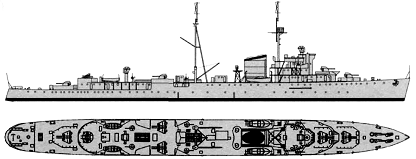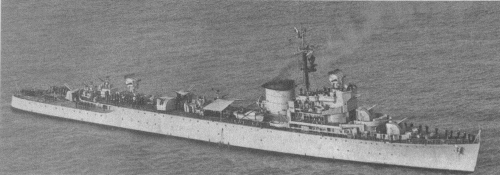
NAVYPEDIA
 Support the project with paypal
Support the project with paypal
Photo

Tromp
Ships
| Name | No | Yard No | Builder | Laid down | Launched | Comp | Fate |
|---|---|---|---|---|---|---|---|
| Tromp | C804 | 240 | Nederladsche Dok- en Scheepsbouw Mij, Amsterdam | 17.1.1936 | 24.5.1937 | 18.8.1938 | barrack ship 12.1955 |
| Jacob van Heemskerck | C803 | 274 | Nederladsche Dok- en Scheepsbouw Mij, Amsterdam | 31.10.1938 | 16.9.1939 | 11.2.1941 | barrack ship 3.1951 |
Technical data
| Displacement standard, t | Tromp: 3787 Jacob van Heemskerck: 3765 |
|---|---|
| Displacement full, t | Tromp: 4817 Jacob van Heemskerck: 4860 |
| Length, m | 125.0 pp 132.0 oa |
| Breadth, m | 12.4 |
| Draught, m | 4.60 |
| No of shafts | 2 |
| Machinery | 2 sets Parsons geared steam turbines, 4 Yarrow boilers |
| Power, h. p. | 56000 |
| Max speed, kts | 33.5 |
| Fuel, t | oil 820 - 860 |
| Endurance, nm(kts) | 6000(12) |
| Armour, mm | belt: 16, longitudinal bulkhead: 30 - 20, deck: 25 - 15, turrets: 25 - 16, CT: 12 |
| Armament | Tromp: 3 x 2 - 149/50 Bofors/Wilton-Fijenoord No.11, 2 x 2 - 40/56 Bofors No.3, 2 x 2 - 12.7/62, 2 x 3 - 533 TT, 1 seaplane (C.XIW) Jacob van Heemskerck: 5 x 2 - 102/45 QF Mk XVI, 1 x 4 - 40/39 QF Mk VIII, 6 x 1 - 20/70 Oerlikon Mk II/IV, 2 DCR |
| Electronic equipment | Jacob van Heemskerck: type 271, type 279 radars |
| Complement | 480 |
Standard scale images

Jacob van Heemskerck 1941

Tromp 1938
Graphics
Project history
In 1931 in the Netherlands the new shipbuilding program has been accepted in which limits designing of 2500t destroyer leader has begun. Designing was conducted by "Nederlandschen Vereinigten Scheepbouw" in the Hague. For a basis designs of British builders Yarrow, Thornycroft and Samuel White have been accepted, however Dutches have refused from 8 120mm guns in favour of 6 150mm, strengthened AA armaments, protected the ship by thin, but extensive enough armour and provided a seaplane. 40% growth of displacement and some fall of speed managed to keep at comprehensible level for joint operations with destroyers. On political grounds ships were officially rated as leaders, and only in 1938 were re-rated as light cruisers. They were intended to replace outdated coast defence ships Hertog Hendrik and Jacob van Heemskerck.
Weight of armour reached 450t, or 13% of standard displacement. 150mm guns "Bofors/Wilton-Fijenoord" No.11 had ballistics identical to guns of De Ruyter, guns in a turret took places in the common gun slide and had max 60° elevation angle. Two 6m rangefinders intended for a fire control, but aft one on Tromp during building was replaced by 4m, besides, because of an overload and speed decrease called by it, have refused installation of 2 twin 40mm MGs. Tromp was equipped with Fokker C.XIW seaplane, but catapult and hangar were not provided by design. The designed machinery power was 56000hp with possibility of short-term forcing to 60000hp, speed of 33.5kts; on trials both ships made 34.5kts, thus Tromp reached 62160hp.
Jacob van Heemskerck to the beginning of German offensive to the Netherlands was been outfitted, armed with only 6 single 20mm Hispano-Suiza MGs. 10.5.1940 she was formally commissioned and escaped to Britain where she was completed at Portsmouth DYd as AA cruiser. The external appearance of the ship was significantly transformed. The armament was completely changed. Instead of 150mm guns Jacob van Heemskerck received 5 twin 102mm/45 DP guns Vickers MkXVI/XIX. For a fire control 2 HACS MkIII directors served. Ship was commissioned again 11.2.1941.
Ship protection
16mm outer armoured belt protected a hull between No.1 barbette and steering gear compartment. More thick (30-20mm) longitudinal anti-torpedo bulkhead placed internally, and flat main deck 25mm was connected with upper edge of this bulkhead, not extended till outer belt or plating. This 25mm (over fwd magazines) - 16mm (over aft magazine) part of deck was closed by 30mm bulkheads. Ship ends were protected by 16mm lower deck. CT and director had 12mm splinter protection, and turrets, barbettes and communication tubes had 25 - 15mm armour.
Modernizations 11.
1942, Tromp: - 2 x 2 - 12.7/62, seaplane with cranes; + 2 x 1 - 76/40 12pdr 12cwt QF Mk I/II/V, 4 x 1 - 20/70 Oerlikon Mk II/IV, 2 x 1 - 12.7/90, SC-3, SG and Mk 3 radars
spring 1943, Jacob van Heemskerck: - type 279 radar; + type 281, 2x type 285 radars
2/1945, Tromp: - 2 x 1 - 12.7/90, 2 x 3 - 533 TT; + 2 x 1 - 76/50 Mk 20/21, 2 x 1 - 20/70 Mk 4
2/1945, Jacob van Heemskerck: - 1 x 4 - 40/39, 6 x 1 - 20/70; + 2 x 2 - 40/56 Bofors Mk IV Hazemeyer), 2 x 2 - 40/56 Bofors Mk VIII/IX, 4 x 2 - 20/70 Oerlikon Mk IV, type 277, 2x type 282, type 293 radars
mid-1945, Tromp: - 4 x 1 - 20/70; + 4 x 1 - 40/56 Mk 1.2
Naval service
Tromp during battle against Japanese destroyers in Badoeng Strait 20.2.1942 received 11 hits of 127mm shells, she was under repair till November, 1942. Tromp 1.12.1955 was converted to barrack ship at Den Helder; 10.12.1968 she was stricken and 13.5.1969 sold for BU to Spain.
Jacob van Heemskerck was stricken from battle list 12.3.1951 and transferred to Vlissingen as barrack ship; 27.2.1970 she was stricken and 23.7.1970 sold for BU to Spain.
Many thanks to Wolfgang Stöhr for additional information on this page.
 HOME
HOME FIGHTING SHIPS OF THE WORLD
FIGHTING SHIPS OF THE WORLD NETHERLANDS
NETHERLANDS CRUISERS
CRUISERS TROMP light cruisers (1938-1941)
TROMP light cruisers (1938-1941)

